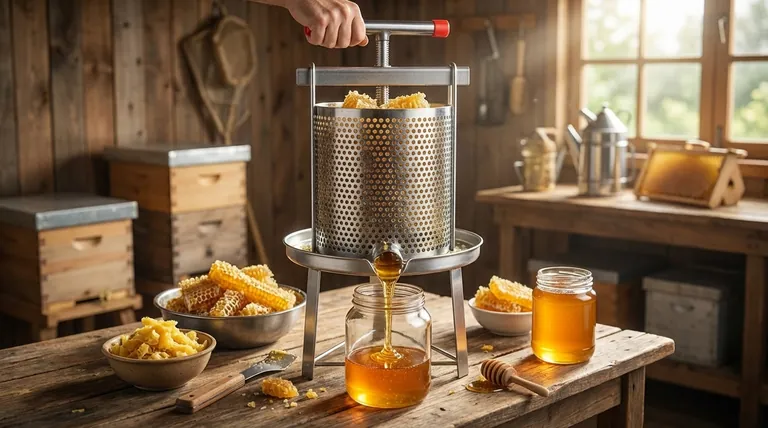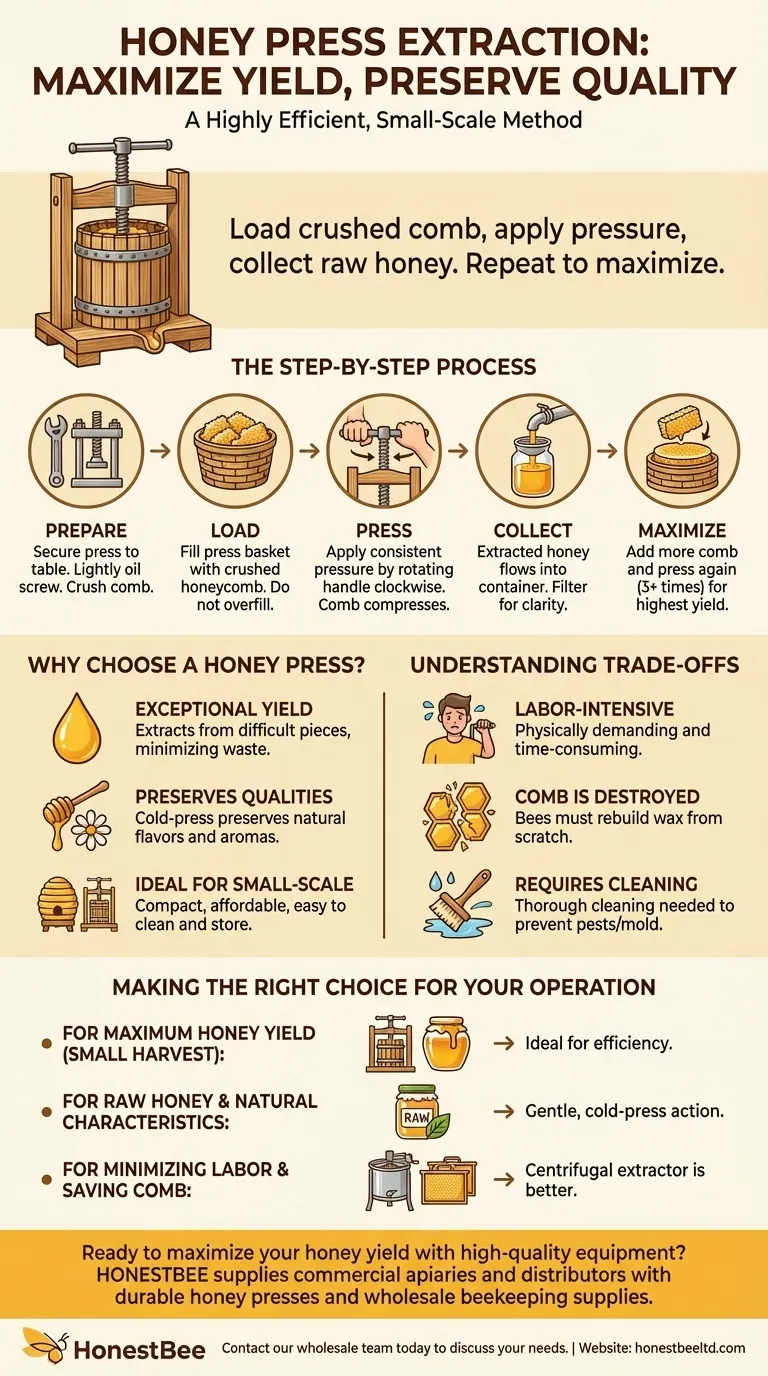To extract honey with a press, you load crushed honeycomb into the press basket, apply pressure by rotating a T-shaped handle, and collect the raw honey as it is squeezed out into a container below. This process is repeated, often by adding more comb to the already compressed wax, to maximize the yield before the final, dry wax puck is removed.
A honey press offers a simple and highly efficient method for small-scale beekeepers to extract the maximum amount of honey, but this high yield comes at the cost of a more labor-intensive process that destroys the honeycomb.

The Step-by-Step Extraction Process
Operating a honey press is a straightforward mechanical process. Success depends on proper preparation and understanding each stage.
H3: Prepare the Press and Comb
Before you begin, it is wise to bolt the press securely to a stable table or workbench to counteract the force required for pressing.
Some operators also recommend lightly oiling the press screw with a food-grade grease to ensure smooth operation. The honeycomb should be cut from the frames and crushed beforehand to make the pressing more effective.
H3: Load the Press Basket
Fill the press's sieving bucket or basket with the crushed honeycomb. Be mindful not to overfill, as this can make the initial pressing difficult.
H3: Apply Consistent Pressure
Set the pressure plate on top of the crushed comb and begin tightening the T-shaped handle, usually in a clockwise rotation. You will feel resistance as the comb begins to compress.
Continue rotating the handle to apply steady pressure. This crushes the honeycomb cells, forcing the honey out through the perforations in the basket while retaining the wax.
H3: Collect and Filter the Honey
The extracted honey flows from a spout at the base of the press into a collection container. This honey will contain fine particles of beeswax and other potential impurities.
For a clean, clear final product ready for bottling, you may want to run the collected honey through a filtering system. Some presses even have built-in filters to aid this process.
H3: Maximize Your Yield
To get the most out of each batch, you can add more crushed comb to the press at least three times before emptying it. The already compressed wax acts as a base, helping to squeeze the honey from the new material more efficiently. The final byproduct is a dense puck of nearly pure, dry beeswax.
Why Choose a Honey Press?
While centrifugal extractors are common, a honey press offers distinct advantages, particularly for certain types of beekeeping operations.
H3: Exceptional Honey Yield
A press is remarkably efficient at extracting honey, minimizing wastage. It excels at processing cappings, burr comb, and other small pieces that are difficult to manage in a centrifugal extractor.
H3: Preserves Natural Qualities
The cold-press method does not heat the honey or subject it to high-speed centrifugal force. Many beekeepers feel this gentle process better preserves the honey's natural characteristics, flavors, and aromas.
H3: Ideal for Small-Scale Operations
With a compact design that is easy to clean and store, the honey press is perfect for beekeepers with a few hives or those just starting out. It allows for processing small harvests without the expense and space required for a large extractor.
Understanding the Trade-offs
A honey press is an excellent tool, but it's essential to understand its limitations to determine if it aligns with your goals.
H3: The Process is Labor-Intensive
Compared to spinning frames in an extractor, crushing comb and manually turning the press screw is physically demanding and time-consuming. This is the most significant trade-off.
H3: The Honeycomb is Destroyed
The "crush and strain" method completely destroys the comb. Bees expend significant energy and resources to draw out wax comb, and reusing it (as is possible with centrifugal extraction) gives a hive a major head start for the next season. With a press, the bees must rebuild from scratch.
H3: Requires Post-Use Cleaning
After use, the entire press must be cleaned thoroughly to prevent mold and attractants for pests. This typically involves disassembly and washing with warm water and a soft nylon brush.
Making the Right Choice for Your Operation
Use your primary goal to guide your decision on whether a honey press is the right tool for you.
- If your primary focus is maximum honey yield from a small harvest: The press is an ideal choice, as its efficiency ensures you extract nearly every drop from your comb, cappings, and burr comb.
- If your primary focus is raw honey with distinct natural characteristics: The gentle, cold-press action is superior for preserving the delicate qualities that many consumers and artisans prefer.
- If your primary focus is minimizing beekeeper labor and saving comb for your bees: A centrifugal extractor is likely a better fit, as it saves the drawn-out comb and is a much faster process for larger harvests.
By understanding its role as a powerful but specialized tool, you can confidently decide if a honey press aligns with your beekeeping philosophy and goals.
Summary Table:
| Step | Key Action | Outcome |
|---|---|---|
| 1. Prepare | Secure press, crush comb. | Ready for efficient pressing. |
| 2. Load | Fill basket with crushed comb. | Comb is prepped for extraction. |
| 3. Press | Turn handle to apply pressure. | Honey is squeezed from the wax. |
| 4. Collect | Honey flows into a container. | Raw honey is extracted. |
| 5. Maximize | Add more comb; press again. | Highest possible yield achieved. |
Ready to maximize your honey yield with the right equipment?
As HONESTBEE, we supply commercial apiaries and beekeeping equipment distributors with high-quality, durable honey presses and other essential beekeeping supplies through our wholesale-focused operations. Our equipment is designed for efficiency and longevity, helping you get the most out of every harvest.
Contact our wholesale team today to discuss your needs and discover how our supplies can support your operation's success.
Visual Guide

Related Products
- Easy Use Manual Stainless Steel Honey Press for Honey Comb
- 6 Frame Manual Stainless Steel Honey Extractor Beekeeping Equipment
- Electric Honey Press Machine for Squeezing Honey Comb Press Equipment
- HONESTBEE 3-Frame Manual Acrylic Honey Extractor
- Stainless Steel Manual Honey Press with Guard for Pressing Honey and Wax
People Also Ask
- What are the steps to operate a bucket honey press? Maximize Your Honey Yield with Simple Mechanical Force
- What is the procedure for pressing honey? A Simple, Low-Cost Method for Small-Scale Beekeepers
- What is the purpose of a honey press? Maximize Yield for Small-Scale Beekeeping
- What is a honey press and how does it work? A Guide to Crush-and-Strain Extraction
- What are the recommended conditions for using a honey press? Achieve Optimal Honey Extraction



















